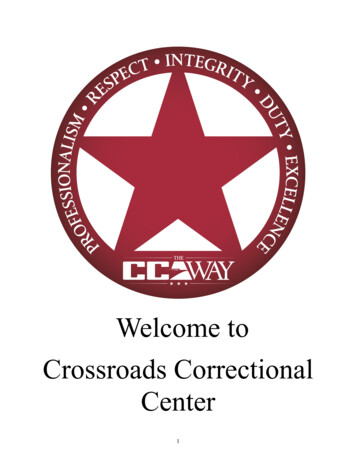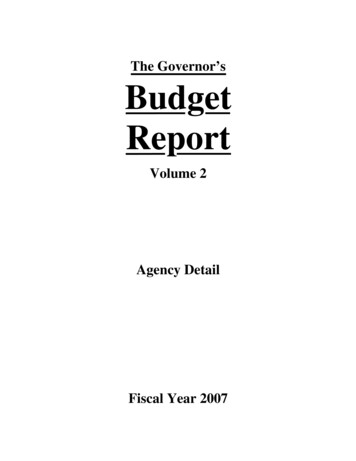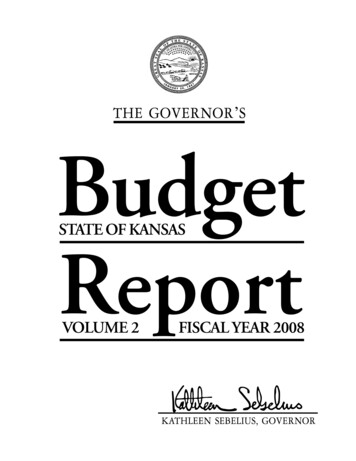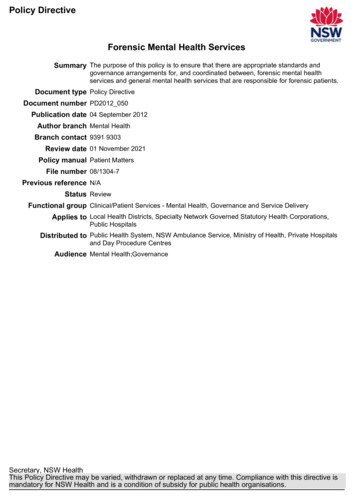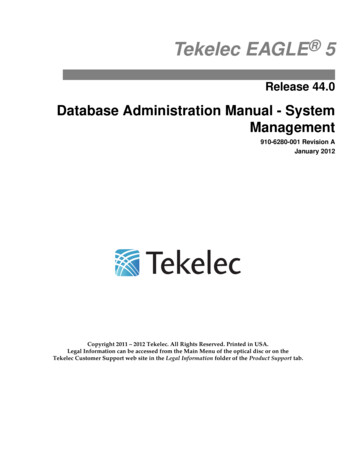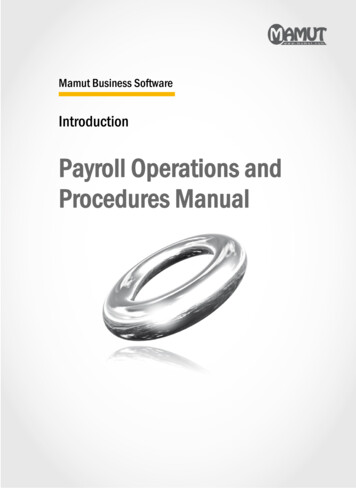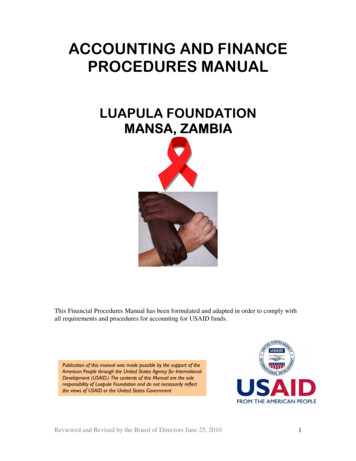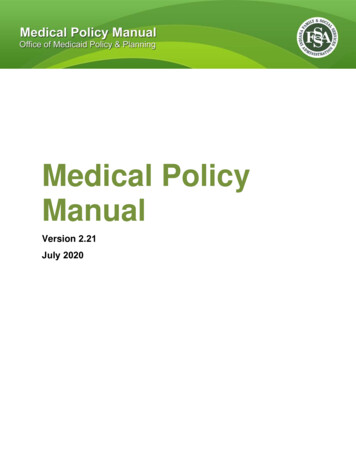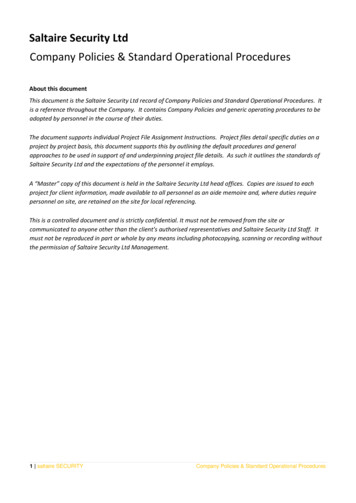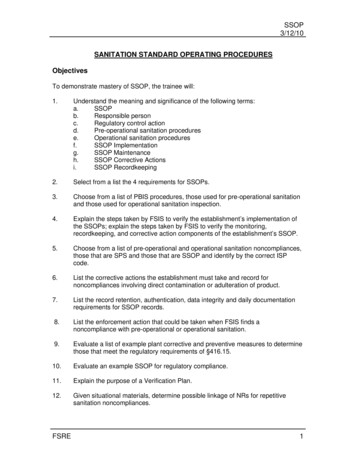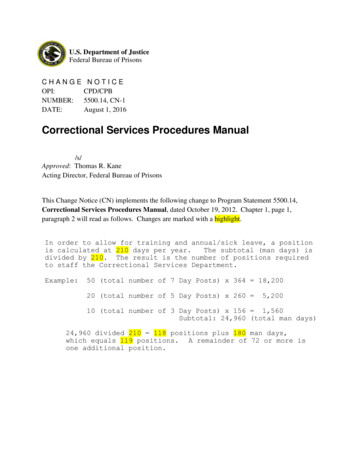
Transcription
U.S. Department of JusticeFederal Bureau of PrisonsCHANGEOPI:NUMBER:DATE:NOTICECPD/CPB5500.14, CN-1August 1, 2016Correctional Services Procedures Manual/s/Approved: Thomas R. KaneActing Director, Federal Bureau of PrisonsThis Change Notice (CN) implements the following change to Program Statement 5500.14,Correctional Services Procedures Manual, dated October 19, 2012. Chapter 1, page 1,paragraph 2 will read as follows. Changes are marked with a highlight.In order to allow for training and annual/sick leave, a positionis calculated at 210 days per year.The subtotal (man days) isdivided by 210. The result is the number of positions requiredto staff the Correctional Services Department.Example:50 (total number of 7 Day Posts) x 364 18,20020 (total number of 5 Day Posts) x 260 5,20010 (total number of 3 Day Posts) x 156 1,560Subtotal: 24,960 (total man days)24,960 divided 210 118 positions plus 180 man days,which equals 119 positions. A remainder of 72 or more isone additional position.
U.S. Department of JusticeFederal Bureau of 5500.1410/19/2012Correctional ServicesProcedures Manual1. PURPOSE AND SCOPE. To implement policies, procedures, andguidelines to protect the public and maintain a secure, safe andorderly living and working environment for inmates and staff.This Program Statement promotes standard management practices forcorrectional staff in all Bureau institutions, while recognizingdifferences among institutions that vary in missions and securitylevels.2. PROGRAM OBJECTIVES.are:The expected results of this programa. Security posts will be established through meaningful postorders; using a standard roster.b. Security will be maintained by well-trained, highlyprofessional correctional staff, guided by clearly written policyand procedures and led by Captains and Lieutenants who monitoroperations, train, advise, and consult with those staff.c. Tools, equipment, and materials will be properly used,stored, and inventoried.d. Continuous inmate accountability will be maintained througha system of accurate counts and census checks.e. Trained canine units will be established in approved Bureauinstitutions and be available to other institutions as needed.f. When mutual Bureau/FBI activity is required to resolve anemergency incident, prior exchange of information and planningwill have occurred, and a plan of action will be in place andapplied.
PS 5500.1410/19/2012Page 2g. Major incidents will be investigated by After-Action ReviewTeams, appointed by Regional Directors.h. Staff will be assigned to posts or duties requiring the useof firearms only after receiving training and continuedrequalification with the issued weapon.i. Inmates sent from Bureau institutions to local medicalfacilities for medical treatment will be supervised by competentand qualified contract personnel when appropriate.3.DIRECTIVES AFFECTEDa.Directives RescindedPS 1440.01PS 5500.08PS 5500.10PS 5511.06PS 5558.14PS 5568.05b.Providing Emergency Assistance to Local LawEnforcement Agencies (5/18/94)Canine Units, Full Service (9/17/97)Guard Service at Local Medical Facilities(3/1/99)Accountability for Inmates (8/4/97)Firearms and Badges (8/24/00)After-Action, Reporting and Review (10/26/00)Directives ReferencedPS 1210.23PS 1280.11PS 1380.05PS 1480.05PS 1600.08PS 2000.02PS 3000.02PS 3420.09PS 3906.16PS 4400.04PS 4500.04PS 5100.07PS 5162.04PS 5216.05PS 5324.03Management Control and Program Review(8/21/02)JUST, NCIC, and NLETS TelecommunicationsSystems (1/7/00)Special Investigative Supervisors Manual(8/1/95)News Media Contacts (9/21/00)Occupational Safety and Environmental Health(8/16/99)Accounting Management Manual (10/15/86)Human Resource Management Manual (11/1/93)Standards of Employee Conduct andResponsibility (2/5/99)Employee Development Manual (3/21/97)Property Management Manual (8/13/01)Trust Fund/Warehouse/Laundry Manual(12/15/95)Security Designation and CustodyClassification Manual (9/3/99)Categorization of Offenses (10/9/97)Juvenile Delinquents, Juvenile Justice andDelinquency Prevention Act (9/01/99)Suicide Prevention Program (5/3/95)
PS 5500.1410/19/2012Page 3PS 5538.04PS 5566.05PSPSPSPS5580.065800.135800.105890.13PS 6000.05Escorted Trips (12/23/96)Use of Force and Application of Restraints onInmates (7/25/96)Personal Property, Inmate (7/19/99)Inmate Systems Management (6/28/02)Mail Management Manual (11/30/95)SENTRY National On-line Automated InformationSystem (12/14/99)Health Services Manual (9/15/96)U.S. Department of Justice Office of Investigative AgenciesPolicies, Resolution 14, and Attachments A and B (PolicyStatement-Use of Deadly Force and Commentaries) (10/17/95)4.STANDARDS REFERENCEDa. American Correctional Association 4th Edition Standards forAdult Correctional Institutions: 4-4091(M), 4-4172, 4-4174,4-4177, 4-4178, 4-4179, 4-4180, 4-4181, 4-4182, 4-4183, 4-4184,4-4185, 4-4187, 4-4188, 4-4196, 4-4202, 4-4204(M), and 4-4205(M)b. American Correctional Association 3rd Edition Standards forAdult Local Detention Facilities: 3-ALDF-1D-18(M), 3-ALDF-1F-05,3-ALDF-2G-03, 3-ALDF-3A-03, 3-ALDF-3A-05, 3-ALDF-3A-06,3-ALDF-3A-07, 3-ALDF-3A-08, 3-ALDF-3A-11, 3-ALDF-3A-12,3-ALDF-3A-14, 3-ALDF-3A-15, 3-ALDF-3A-22, 3-ALDF-3A-28,3-ALDF-3A-30, and 3-ALDF-3A-32(M)c. American Correctional Association 2nd Edition Standards forAdministration of Correctional Agencies: 2-CO-3A-01d. American Correctional Association Standards for AdultCorrectional Boot Camp Programs: None5. PRETRIAL/HOLDOVER PROCEDURES. Procedures required in thisProgram Statement apply to pretrial/holdover inmates and INSDetainees in Bureau Custody.6. DEFINITIONS. Throughout this Program Statement, there isreference to guidelines and requirements based on the securitylevels of institutions. For the purpose of security levelidentification, administrative facilities will be governed underthe same guidelines as medium security facilities, unlessotherwise noted.7. REPRODUCTION OF ATTACHMENTS. All attachments included inthis Program Statement may be reproduced locally or acquired viaBOPDOCS.
PS 5500.1410/19/2012Page 48. RETENTION OF DOCUMENTS FOR CORRECTIONAL SERVICES. In orderto maintain a record of past information, the retention of thesedocuments must be stored for future reference. The duration foreach document is listed on the Retention of Documents List(Attachment A).9. IMPACT ON MASTER AGREEMENT. This document is to be reviewedin conjunction with the negotiated Master Agreement. If thereare any contradictions between the two documents, the MasterAgreement will prevail.10. INSTITUTION SUPPLEMENTS. The following provisions of thisManual require Institution Supplements:a. Chapter 2 (page 1), Section 200.1, tool control proceduresand tool control inspection system.b. Chapter 2 (page 2), Section 201.2, a list of all tools byClass AA, A, and B including descriptions and size of all toolscurrently in use.c. Chapter 2 (page 4), Section 204.2, procedures for using theGovernment-wide Credit Card Program to purchase tools.d. Chapter 2 (page 9), Section 207.1, procedures to carry outthe tool survey process including the destruction of any surveyedtools.e. Chapter 3 (page 4), Section 304.1, guidelines andprocedures for conducting census checks./s/Charles E. Samuels, Jr.Director
PS 5500.1410/19/2012Table of Contents, Page iTABLE OF CONTENTSCHAPTER 1MANAGEMENT OF CORRECTIONAL SERVICES100101102103104105106107COMPUTING THE CORRECTIONAL COMPLIMENTQUARTERLY AND DAILEY ROSTER ASSIGNMENTOFFICER ASSIGNMENT RECORDPREPARATION, USE, AND DISTRIBUTION OF POST ORDERSOPERATIONAL REVIEW OF CORRECTIONAL SERVICESLIEUTENANTS’ MEETINGSINTELLIGENCE BRIEFINGSUNIFORM REGULATIONSCHAPTER 2TOOLS AND HAZARDOUS NSIBILITIESTOOL CLASSIFICATIONTOOL IDENTIFICATIONSTORAGE IN WORK AREASTOOL INVENTORIESISSUING TOOLSLOST TOOLSDISPOSITION OF EXCESS TOOLSWEAPON MANUFACTURE CONTROLCONTROL OF FLAMMABLE, HAZARDOUS, POISONOUSMATERIALS AND CHEMICALSCONTROL OF DANGEROUS DRUGS AND HYPODERMIC APPARATUSCONTROL OF FOOD SERVICE EQUIPMENTCHAPTER 3COUNTS - CENSUS CHECKS300301302303304305306307308309310BASIC PRINCIPLESOFFICIAL COUNTSEMERGENCY COUNTSOFFICIAL COUNT FORMCENSUS COUNTSCONTROL CENTER RECORDSDAILY CHANGE/TRANSFER SHEETINMATE CALL-OUTSPASS SYSTEMDETAIL/CREW KIT CARDSSPECIAL ACCOUNTABILITY
PS 5500.1410/19/2012Table of Contents, Page iiCHAPTER 4EMERGENCY ASSISTANCE TO NON-FEDERAL CORRECTIONAL INITIONMEMORANDUM OF UNDERSTANDINGREVIEW BY/NOTIFICATION OF REGIONAL DIRECTOR AND ASSISTANTDIRECTORTYPICAL ASSISTANCE AND GUIDELINESCRISIS MANAGEMENT TEAMSUPPORT ASSISTANCE BY OTHER FEDERAL AGENCIESREPORTING REQUIREMENTSANNUAL REVIEW OF MEMORANDUM OF UNDERSTANDINGASSISTANCECHAPTER 5CANINE LER SELECTIONCANINE SELECTIONHANDLER RESPONSIBILITIESEMPLOYEE GUIDELINESHEALTH, CARE, AND FEEDINGTRAININGTRAINING DOCUMENTATIONPROCUREMENTCHAPTER 6AFTER-ACTION REVIEW AND ACTION REVIEW TEAMAFTER-ACTION REVIEW TEAM FOR DISCHARGE OF FIREARMSHOOTING INCIDENT REVIEW COMMITTEEAFTER-ACTION REPORT FORMATINMATE INVOLVEMENTSUMMARY REPORT FORMATDISCLOSURE OF BUREAU STAFF NAMES IN MAJOR INCIDENTS
PS 5500.1410/19/2012Table of Contents, Page iiiCHAPTER 7FIREARMS AND BADGES700701702703704705706DEFINITIONSCARRYING OF FIREARMSUSE OF FIREARMSARMED ESCORT BY COMMERCIAL AVIATIONREPORTING REQUIREMENTSIDENTIFICATION BADGESNON-DISCLOSURE OF BUREAU STAFF NAMES IN SHOOTING INCIDENTSCHAPTER 8GUARD SERVICE AT LOCAL MEDICAL FACILITIES800801802803RESPONSIBILITIESSUPERVISION REQUIREMENTSCONTRACTOR ELIGIBILITYCONTRACT REQUIREMENTS
PS 5500.1410/19/2012Chapter 1, Page 1CHAPTER 1MANAGEMENT OF CORRECTIONAL SERVICES100. COMPUTING THE CORRECTIONAL COMPLEMENT. A total of 364 daysis used as a base year for a 7-day post. A 5-day post is 260days. These figures are determined by multiplying the number ofdays per week a post is manned, i.e., 7-day post, 5-day post, 3day post, and etc., by the amount of weeks in a year (52). Afterdetermining the total number of each post in an institution (7day post, 5-day post, and etc.), each total is multiplied by theappropriate base year figures (see examples below).In order to allow for training and annual/sick leave, a positionis calculated at 210 days per year. The subtotal (man days) isdivided by 210. The result is the number of positions requiredto staff the Correctional Services Department.Example: 50 (total number of 7 Day Posts) x 364 18,20020 (total number of 5 Day Posts) x 260 5,20010 (total number of 3 Day Posts) x 156 1,560Subtotal: 24,960 (total man days)24,960 divided 210 118 positions plus 180 man days, whichequals 119 positions. A remainder of 72 or more is oneadditional position.To determine the authorized correctional complement for aparticular Bureau institution, the following definitions andcalculations should be clearly understood:1. Post. A post is the location or assignment that isactually worked by a staff member.2. Position. A position is the actual person or personsnecessary to work a given post.101. QUARTERLY AND DAILY ROSTER ASSIGNMENT. A quarterlyassignment roster will be prepared at 13-week intervals,corresponding with annual evaluation periods. At institutionswhich confines both males and females inmates, at least one maleand one female staff must be on duty each shift. Thisrequirement is not limited to correctional officers only. Forinstances, the presence of case managers, counselors, physicianassistants, etc. will fulfill this requirement.
PS 5500.1410/19/2012Chapter 1, Page 21. Rotation Policy. Correctional Officers are subject to postrotation in accordance with the negotiated agreement.Lieutenants will be rotated two weeks prior to the regularassignment roster's effective date.Probationary officers will be rotated monthly. In accordancewith the Master Agreement, probationary staff may work nonprobationary posts on overtime or on an as needed basis based onspecific needs of the institution.2. Rosters. When possible, post titles on the quarterly anddaily rosters must reflect the duties the officer actuallyperforms. If an assignment's duties are widely varied, the postcan be named to identify the major duties involved, with allduties identified in the post orders.Lieutenants are responsible for ensuring the daily roster isaccurate. Pen/pencil markings or other alterations to the dailyand quarterly rosters are prohibited.The Computerized Correctional Services Roster Program is theonly program authorized for the production of Quarterly Rosters,Daily Rosters, Assignment Cards, etc.3. The local union president or his/her designee will beprovided read-only access (including the ability to print) to theCorrectional Services Roster Program.102. OFFICER ASSIGNMENT RECORD. An Assignment Record will bemaintained on each officer, including probationary officers. Thefollowing information will be entered in chronological order atthe top of the form:1.Full Name2.Date of Entry on Duty3.Current GradeAny reason for deviation from normal rotation will be noted afterthe assignment entry, i.e., job related, self-improvement orlimited assignment for health reasons. For those staff unable tocomplete the rotation, documentation on the assignment recordwill reflect the reason for non-rotation.
PS 5500.1410/19/2012Chapter 1, Page 3103.PREPARATION, USE, AND DISTRIBUTION OF POST ORDERS.Post Orders must be based on Bureau and institution policies, andmust state each post's duty hours.Post Orders must be prepared under the Captain's supervision anddirection. The Captain will sign and date the last page of eachsection, and initial and date subsequent page changes. A PostOrder Master File will be maintained in the Lieutenant’s officefor availability to all staff. When a new or differentassignment is know sufficiently in advance each staff member mayrequest a reasonable amount of duty time to read the post orders.Ideally, this should take place prior to or immediately uponassuming such a post (if the nature of the post permits it).There are occasions when there is no opportunity to read the postorders. In these cases, it is the responsibility of the employeeto inform the employer of the fact they have not been able orafforded the opportunity to read such orders. The employer willthen advise the employee of the general requirements of the post,and answer any questions. Employees assuming posts under thesecircumstances still have the responsibility of exercising soundcorrectional judgment based upon their training and experienceand will make reasonable efforts to read the post orders as soonas practicable.After reading the post orders, the employee must sign and datethe Post Order Review Sheet (Attachment E) which is located inSection 5 of the document. This may be accomplished in one oftwo places, either the Lieutenant’s office or on the site post.Programs Statements, Operation Memorandums, and otherinstructions will be made available.Each Post Order will contain instructions regarding the immediateaction staff should take in an emergency particular to theparticular post or location of the post they occupy. These“first responder” instructions should contain specific actionsteps including, but not limited to, containment, staffprotective considerations, and emergency reporting protocols.Particular requirements regarding assaultive inmates, suicides,fires, evacuation routes, and other “immediate” responseemergency situations should be addressed. These instructionsshould be consistent with the corresponding Emergency Plan.In accordance with their position descriptions, staff will reviewPost Orders of their assigned posts.
PS 5500.1410/19/2012Chapter 1, Page 41. Housing Unit Post Orders. The Captain and Unit Managerwill review and sign jointly all Post Orders (and subsequentchanges) for housing units under a Unit Manager's supervision.While post orders are an assignment of work, there may be postorder changes that effect conditions of employment which maywarrant bargaining over procedures and appropriate arrangements.Housing Unit Post Orders will direct the assigned staff memberto maintain a unit log of pertinent information regarding inmateactivity.The Post Orders must reiterate to staff that inmates do nothave any authority over other inmates. The Post Orders muststate clearly that staff are responsible for supervising inmates.2. Format of Post Orders. Post Orders will describe allprocedures and any special instructions regarding a specificpost. Post Orders are to contain five separate sections in thefollowing order:Section 1 -- Activities listed chronologically withresponsibilities clearly defined.Section 2 -- Special instructions relating to the specificpost.Note:Post Orders for armed posts, and posts whichcontrol access to the institution perimeter, mustcontain a statement to the effect that anyemployee taken hostage is without any authority,regardless of rank or position. Additionally,specific instructions for helicopter escapeattempts must be included in Post Orders for armedposts.Note:Also, the Program Statement on Firearms and Badgeswill be included in Section 4 of the post orders.Institutions with armed posts, the Post Orders must containspecific instructions for:(1)The proper care and safe handling of firearms.(2)When use of firearms is authorized.Note:Post Orders must specifically allow staff toreturn fire when fired upon first.
PS 5500.1410/19/2012Chapter 1, Page 5Section 3:General Post Orders - applicable to all posts.Section 4: List of Program Statements and InstitutionSupplements relevant to the post.Section 5:3.Employee Signature sheet.Maintenance of Post Ordersa. Post Orders will be kept current. All changes will beincorporated into the post orders upon approval by the Captain.b. Post Orders and log books are confidential documents andshould never be left unattended or in an area accessible toinmates.Post Orders must be secured at all times when not in use bystaff.c. The Captain will maintain historical files and copies ofbackup disks of post orders (see Attachment A for retentioninstructions).d. Regional Correctional Services Administrators are toreview the Post Orders during staff assist visits.4. Armed and Perimeter Access Post Assignments. Officersassigned to armed posts must qualify with the firearms assignedto that post prior to post assignment.Except for emergencies, or as authorized by the Warden, armedemployees are assigned only to towers, mobile patrols, or otherpositions inaccessible to inmates.Post Orders should also contain specific guidelines ofpersonnel entering/exiting the front entrance and rear gate.104. OPERATIONAL REVIEW OF CORRECTIONAL SERVICES. Refer to theProgram Statement on Management Control and Program Review,Chapter 2, Operational Reviews.The Captain will develop and maintain a quarterly perpetual auditschedule. Reviews should be based on identified trends and theneeds of the institution. A system of correcting identifieddeficiencies will be implemented.105. LIEUTENANTS' MEETINGS. A Lieutenants’ meeting will be heldmonthly to discuss programs and problem areas of general concern.
PS 5500.1410/19/2012Chapter 1, Page 6 Missing tools will be discussed at this meeting. Lieutenants in attendance will be listed in theminutes. A recorder will be assigned to compose the minutes. The minutes will be submitted to the CorrectionalServices Administrator, Regional Office, monthly.At a closed meeting, either before or after the formal meeting,the Captain and Lieutenants will review the progress and evaluateeach probationary officer’s performance.106. INTELLIGENCE BRIEFINGS. In an effort to enhancecommunications, intelligence briefings will be conducted withinstitution executive staff. Standard topics should includeupdates on all active investigations, serious incidents (i.e.,fires, fights, assaults, homicides, etc.), subpoenas/FOIArequests, phone/mail abuse, urine surveillance, alcohol testing,security threat groups, inmate housing, work details, etc.Each institution will develop a system to pass on appropriateintelligence to staff.107. UNIFORM REGULATIONS. Uniforms will be worn in accordancewith the uniform policy and Master Agreement.Staff will not carry on their person potentially hazardous items,such as pocket knives, large amounts of cash, chemical agents,utility tools (leatherman), personal pagers, personal handcuffand key, cellular telephones, personal computers, etc.
PS 5500.1410/19/2012Chapter 2, Page 1CHAPTER 2TOOL AND HAZARDOUS MATERIALS200.RESPONSIBILITIES1. Each institution is responsible for developing anInstitutional Supplement outlining tool control procedures andinspection system. Department heads will be responsible forimplementing this procedure in their departments.2. The following paragraphs describe the fundamentals of goodtool control. This outline is flexible enough to be adaptable inall institutions, but is expected to be defined clearly in theInstitution Supplement.Each institution will designate, or by selection to a permanentposition, a staff member as the Tool Control Officer. This staffmember will insure the tool inventories and procedures arecompleted.201.1.TOOL CLASSIFICATIONAll tools will be classified under three general headings: Dangerous (Class AA) Hazardous (Class A) Non-hazardous (Class B)The Class AA group includes those tools deemed too dangerous toinstitutional security for an inmate ever to handle withoutconstant, visual staff supervision. These tools must be securedin a manner which deny inmates even the remotest possibility ofaccess.This classification is for all security level institutions,except for independent or satellite camps, and outside workdetails, as long as the tools do not come within 25 feet of theinstitution’s outer fence or secure perimeter.a. Class AA tools must be removed from the institution atthe end of each work day, or stored in a combination locked safein a Class A tool room, the Armory, or turned into the ControlCenter.Class AA tools are identified as:(1)Metal Cutting Blades.
PS 5500.1410/19/2012Chapter 2, Page 2(2)Bolt Cutters.(3)Ramset Gun and ammunition (stored in Armory only).(4)Any Diamond Tipped Tool.b. Explosive and flammable compressed gas tanks (exceptmedical oxygen) inside the perimeter must be severely limited.At the end of each workday all such tanks will be removed fromthe secure perimeter and secured in an appropriate lockablestorage. These tanks must be secured while inside the secureperimeter of the institution while in use.The Class A group includes those tools: most likely to be used in an escape or escape attempt,used to manufacture or serve as weapons capable ofdoing serious bodily harm;as being hazardous to institutional security orpersonal safety;mixing chambers; orcore drill bits.The Class B group includes tools of non-hazardous nature.2. Each institution must include in its Institution Supplementa separate Class AA, Class A and Class B alphabeticalclassification list of all tools, by description and size,currently in use at that institution.Lists that give examples of tools in use are not sufficient.a. The tool list will be included in the InstitutionSupplement as an attachment. The tool list attachment should bereviewed quarterly and updated as needed.b. Tools that are a part of a set or sized sequentially bystandard increments can be in a single listing. For example:Drill bits, metal/wood1/32" - ½" amount of piecesDrill bits, metal/wood7/16" - 7/8" amount of piecesWrench, comb. box/open end1/4"Wrench, comb. box/open end7/16" - 7/8" amount of pieces- 7/16" amount of piecesFor instance, the institution has a combination box/open endwrench, size 1 7/8", and there are no smaller or larger sizes,the wrench will be a single listing.
PS 5500.1410/19/2012Chapter 2, Page 3202.TOOL IDENTIFICATION1. The Tool Control Officer must mark the tools (steel orshank portion of the tool) in each work location with anidentification symbol which identifies the storage area of thetool when not in use.2. Tools which cannot be marked without damage, such assurgical instruments, micrometers and small drill bits, areinventoried and kept in locked storage areas when not in use.203.STORAGE IN WORK AREAS1. A shadow board is considered the best method of storing alltools which can be mounted. All shadow boards will have whiteClass AA tool will be shadowed inClass A tools will be shadowed inClass B tools will be shadowed inbackgrounds.bright (curb) yellow.redblack.Only one tool will be kept on each shadow.identical in size and shape of the tool. The shadow must beTools not adaptable to a shadow board must be kept in alocked drawer or cabinet and inventoried accordingly.Hospital "sterile packs" will have a predetermined inventoryper package and must be processed by a staff member. The packswill only be opened when there is suspicion or evidence aninstrument is missing from the pack(s).A hospital staff member must be contacted or present if asterile pack requires opening for security reasons. Sterilepacks as well as extra instruments must be stored under lock andkey at all times. Extra instruments will be bin carded.2. Any Class A tool, whether in a central tool room or workarea, must be stored in a metal cage or Class I concrete walledroom.These tools must be physically separated from Class B tools,behind two locked doors.
PS 5500.1410/19/2012Chapter 2, Page 4When the Class A tool room is inside the Class B tool room, thelock on the Class B tool room door serves as one of the tworequired locks for the Class A tool room.3. When a tool is removed from the inventory, thecorresponding shadow will be removed immediately from the shadowboard.4. Detail Supervisors will ensure that all tools are accountedfor prior to the end of any work period (lunch breaks, workday).At the Captain’s discretion tools may be returned at those timesto their storage site.204.TOOL INVENTORIES1. Tool inventories will be numbered and posted conspicuouslyon all corresponding shadow boards, tool boxes, and tool kits.The Master Inventories will be maintained by the Tool ControlOfficer.2. All tools will be received in the appropriate warehouseunless the warehouse is located within the institution's secureperimeter. If the warehouse is located within the secureperimeter, other procedures will be developed, forinstance, tools may be stored at the rear sallyportuntil properly receipted.These tools will be picked up and receipted by the Tool ControlOfficer. Tools such as bandsaw blades, files, and all Class AAtools, will be turned over immediately to the Tool ControlOfficer for secure storage.Tools purchased with a credit card will be delivered to theTool Room Officer for proper classification, marking, andplacement on the appropriate inventories.Credit card and purchase orders will be routed to the tool roomofficer for accountability purposes.Institution Supplements must have defined specific procedureson using the Government-wide Credit Card Program for purchasingtools.3. Tools will not be manufactured at the institution withoutthe Captain’s prior approval.
PS 5500.1410/19/2012Chapter 2, Page 54. An annual inventory of all tools currently in use in theinstitution will be conducted each year during the month ofJanuary. The Tool Inventory Form (BP-219) is the only documentauthorized for this review.a. Employees responsible for tools in their areas and theTool Control Officer will conduct the annual inventories andcertify accuracy.b. Each Department Head will approve the inventories fortheir areas.5. Quarterly reviews will be conducted during the months ofApril, July, and October. During the verification process,inventories, tools, and shadow broads will be inspected to ensurecompliance with policy.a. The employee who is responsible for tools in each areawill conduct the reviews and verify the inspection, including theinventory’s accuracy, by initialing the Master Tool Inventoryform in the appropriate quarterly column. It is not necessaryfor the employee to sign every blank on the form to indicatehis/her verification of these tools.b. The Supervisory staff from each department will monitorthe quarterly tool reviews. The supervisory staff will sign thebottom of the Master Inventory form certifying the quarterlyreview was conducted and the inventory is accurate.Although all tool inventories must be accurate, only the MasterTool Inventories (maintained by the Tool Control Officer) requirethe signatures and initials of responsible staff denoting thequarterly inspections/reviews were conducted according to policy.6. The Tool Control Officer will maintain a separate filefolder for each shop or area in which tools are stored. The leftside of the folder will contain the master annual inventorysheet(s).When a change, such as additions or deletions, is made to themaster inventory, the Tool Control Officer will retype or reprintthe page on which the change occurred completely and insert it inthe master inventory. The new page will also be posted on theappropriate shadow board, tool box, and/or tool kit. Allresponsible parties must sign any new page which has beenchanged.The Captain must approve all additions to the tool inventories. To add a tool, the detail supervisor/Department Head
PS 5500.1410/19/2012Chapter 2, Page 6must submit a memorandum to the Captain through theTool Control Officer. The name, size, and quantity ofthe tool must be identified in the memorandum.The old page will be moved to the right side of the folder forreference purposes. Do not destroy these pages for the currentyear.The right side of the folder will also contain, but is notlimited to, the following documentation: Lost or Missing Tool Reports/Found Tool Reports(BP-220),requests for additions and deletions to inventories,Survey Requests and Reports,Storeroom Requisition Forms, andany other documents
24,960 divided 210 118 positions plus 180 man days, which equals 119 positions. A remainder of 72 or more is one additional position. To determine the authorized correctional complement for a particular Bureau institution, the following definitions and calculations should be clearly unde
